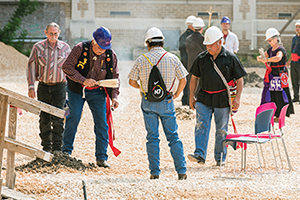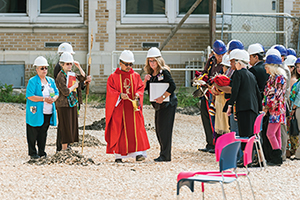By DALE SINGER
When excavation work for a prayer garden at The Children's Hospital of San Antonio unearthed long-buried human remains, it also bared long-simmering resentments.

Raymond Hernandez, a ceremonial elder and descendant of the Coahuiltecan tribe, uses a fan made of bald eagle feathers to cleanse and bless graves at a service to reinter human remains long buried on the campus of The Children's Hospital of San Antonio. Smoke from his sage bundle carries prayers up to the sky.
The CHRISTUS Santa Rosa Health System hospital was built on ground that had been a Catholic cemetery. According to historical accounts, up to 3,000 bodies from that site and an adjacent cemetery had been exhumed and moved within 24 hours in the 1920s to clear land for downtown development. The interred included Native Americans, Canary Islanders, soldiers and Tejanos — Texans who are descended from the original Spanish-speaking settlers. Some of the bodies were left behind in the 1920s exhumation.
When groups of present-day descendants learned about the discovery of the graves on the hospital campus, and the hospital's intention to move the remains, they expressed indignation and asked to be included in decisions involving the graveyard. The hospital welcomed their input.
Dennis Gonzales, the hospital system's regional vice president for mission integration, said the hospital and descendants arrived at an outcome that demonstrates respect for the descendants and for the sanctity of the remains — a solution that also allows for the construction of the prayer garden on top of the hallowed ground.
Gonzales said, "I think everyone just paused and thought, wow, this has always been a holy ground. It remained a sacred ground because of work the (Sisters of Charity of the Incarnate Word) have done there, caring for the descendants of those who were buried there. I think all of us coalesced around that idea."
Meetings with descendant groups presented "an amazing opportunity to listen and learn" about the hardships Native Americans and the Spanish-speaking settlers and their descendants have endured over centuries, Gonzales said. "We sat with our minds open and ears open to listen to their accounts of what they have been through during the years." He said of the ultimate solution to the groups' grievances, "We couldn't be more pleased as a Catholic organization at the way it turned out."
Perpetual care
After a construction crew doing site preparation work for the prayer garden found human remains in September 2016, the hospital halted work. It enlisted Shawn Marceaux, director of the Center for Archaeological Research at the University of Texas at San Antonio, to survey the site and flag the likely position of graves. Marceaux said his team removed articulated remains from six graves in the initial work and transferred those remains to his lab at the center. He estimates there are at least another 70 graves on the site, all likely dating from the 19th century. Archaeologists found a few personal items including buttons and a metal arrowhead. Most of the graves at the site were undisturbed by the archaeologists, Marceaux said.
Gonzales said the archaeological work took several months.
"They're literally sifting through dirt," he explained, "and that's a very long, painstaking, detailed process. You don't want to disturb the remains. You can't rush that."
The hospital got a court order in March removing the cemetery designation and authorizing the reinterment of all human remains away from the hospital campus, in a cemetery with a perpetual care covenant. The descendant groups did not see the legal notice of the court order when it was published in a local newspaper. Marceaux said when descendant groups heard about the archaeological survey work and plans to move the remains, they felt offended and excluded from the process. That's when the groups approached the hospital.

Fr. Roy Quiogue, CICM, and Chaplain Peggy Huber, center, members of the spiritual care team at The Children's Hospital of San Antonio, prepare to spread holy water as part of a September ceremony in which ancestral remains were returned to the ground where they were discovered during renovations.
"Some of the specific groups felt they didn't have the notification they would have liked," Marceaux said. "But once we all got in a room together and started talking about where things were, they had the chance to express their concerns and what they wanted. To the hospital's credit, it was very receptive and worked hard to make things right."
From confrontation to compromise
Ramón Vásquez, executive director of the group American Indians in Texas at the Spanish Colonial Missions, said the hospital was open to meeting with the groups to address concerns and that receptivity defused tensions. "We were prepared for a fight," he said. "We had lawyers ready to move into the courts if we needed to.
"We went in there with a very basic demand. We did not want the cemetery designation removed, and we wanted the remains left in place. According to the hospital, they did everything they needed to do under the law. What we did was humanize the entire project," Vásquez said.
A hospital spokesperson said that at the hospital's request, the judge reinstated the cemetery designation.
Marceaux said descendants came to his lab at the university to prepare cloth burial bundles of the remains for reinterment. On Sept. 6, nearly a year after the first bone fragments were uncovered, the hospital hosted a reinterment ceremony. A Catholic priest and Native American ceremonial elder offered prayers and blessings.
Eternal rest, perpetual vigilance
Vásquez described the ceremony as a prayer for forgiveness and everlasting rest. Prayers asked "that no harm come to any of us or any of the ones who disturbed them. That's the intention when we have our reburial, is that they be laid to rest forever with the promise that they never be disturbed again."
Patricia Mota's great-grandmother, Concepcion Charli Losoy, was in the Alamo during the famous battle there in 1836 and was thought to be buried in the cemetery on the hospital site in 1860. Mota said she appreciated the sensitivity the hospital showed in the reinterment ceremony.
"It was very, very beautiful," she said. "It was very moving. I didn't realize how much it was going to move me, when the prayers were being said."
Descendant Mari Tamez said she too felt very emotional — overwhelmed and humbled even, but also appreciative of the spiritual nature of the service. Tamez said, not knowing what to expect, she came prepared to add a personal blessing, if necessary: "I had brought my own holy water, just in case."
Gonzales noted that the hospital campus had been the site of many previous construction projects and also earlier discoveries of remains, most recently in the 1990s.
"When this occurred," he said of the latest find, "it wasn't a complete surprise, but to be honest with you, we felt that after all of the construction, that we would be done."
Of the final resolution, Marceaux said: "It was really amazing to see folks get together. I think everybody involved here set their sights on how they wanted to proceed and close this chapter. I think that was accomplished. I think there was a sense of closure. You can't ask for a much better outcome."
Tamez said she hopes that the process of protecting the cemetery will lead to more respect for the city's history and those who played a part in it.
To Vásquez, the entire situation has reinforced the sense of duty that he and his fellow descendants feel in protecting their heritage.
"It's pretty heavy," he said. "We obligate ourselves to that as a community."
Copyright © 2017 by the Catholic Health Association
of the United States
For reprint permission, contact Betty Crosby or call (314) 253-3490.